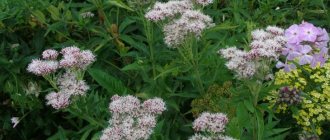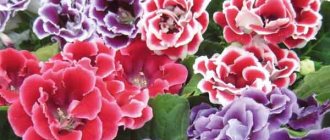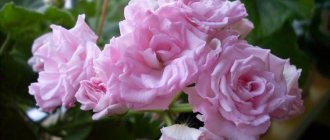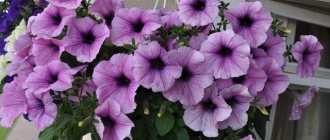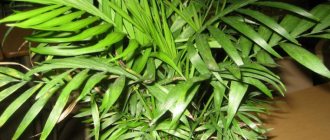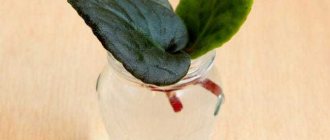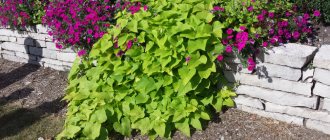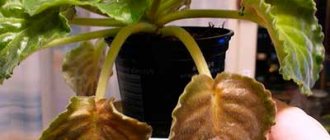Origin and appearance
Work on creating a paniculate garden crop capable of changing color has been carried out since the end of the 19th century. in France. Hydrangea Vinyl frieze is the result of breeding activities, which is why it was able to give it a number of characteristics.
Appearance of hydrangea Vanilla Fraze
For your information! The variety received its name because of its complex color, where white (vanilla) alternates with pink. The name translates as “vanilla strawberry”.
The stems of the plant are burgundy in color. The shoots are straight and rigid; under the weight of the vegetative part, the bush takes on a spherical shape. The leaves are oval, oblong. The inflorescences are cone-shaped, oblong, consisting of large flowers of a rich pink hue at the base, turning to vanilla at the top.
Description of flowering
The plant typically flowers in several stages. It starts in mid-June and lasts until October. By summer, buds appear and bloom like white flowers. Then gradually they turn to pink. In autumn, you can observe that the inflorescences turn burgundy-red.
Hydrangea Vanilla Fraze on a trunk
Some garden crops are grown in the shape of a tree to make them decorative. The part of the trunk up to the first lower tier of the stem is called the trunk. Planting and caring for the formation of a tree trunk require patience and time. It will take at least three years to obtain a standard culture.
The idea of forming a tree from a hydrangea is based on the fact that young shoots acquire rough bark and cannot send out young shoots. Only the top of the plant continues to develop further.
Hydrangea Vanilla Fraze on a standard
Diseases and pests
Most diseases of this flowering shrub are caused by improper watering, which results in waterlogging of the soil. As a result, hydrangea is affected by downy mildew. The main signs of the disease are:
- the appearance of yellow spots on the foliage, which subsequently darken;
- A gray coating appears on the back of the leaves.
To combat the disease, spraying with fungicidal preparations is used. The number of waterings should also be reduced.
Gray mold is another disease caused by fungi. As a result, small brown spots appear on the upper part of the leaf blades, which increase over time, merging into one large spot. All vegetative parts of the plant infected with rot should be immediately removed and burned. All plants are sprayed with the fungicidal preparation Rovral Flo 255 SC. Repeated treatment is carried out after 12-14 days.
Gray rot on hydrangea
If there is too much humus or lime in the soil, chlorosis may affect the hydrangea. Main signs of the disease:
- sharp lightening of the color of leaf plates with further yellowing;
- the veins on the leaf plates do not change their color;
- diseased leaves fall off.
In this case, preparations that increase its acidity (Antichlorosis, Ferovit) should be added to the soil.
Among the pests, this flowering perennial is attacked by spider mites or aphids. What to do in this case? Fufanon (or Thiophos) is effective against the first “harmful” bug. Aphids can be controlled by spraying foliage with a solution of Intavir or Actofit.
What does the plant suffer from?
Pests do not visit hydrangea bushes, only due to lack of moisture the leaves begin to dry:
| Cause | Solution |
| The leaves are turning yellow | Changes in the shade of leaf blades are caused by a lack of light or moisture, low acidity of the soil. |
| No flowering | Many of the problems of paniculate hydrangea are due to the soil - it must be nutritious and slightly acidic. |
Vanilla Fraze is a beautiful shrub with large inflorescences that last on the bush for 2-3 months. According to reviews from experienced gardeners, the plant requires minimal care and timely watering, then the inflorescences will show themselves in all their beauty.
Why doesn't it bloom
It happens that, having bought seedlings, a gardener follows all the recommendations for preparing the soil and planting, shelters the plants from direct sun and wind, but cannot achieve flowering. In this case, the cause may be diseases that weaken the immunity of the plant, which simply does not have the strength to form flower shoots.
Interesting! Drying of inflorescences can be caused by unfavorable environmental conditions, as well as diseases and pests.
There are several types of diseases based on the type of pathogen. Fungal diseases - white rot and gray rot - are provoked by a pathogen found in the soil. Signs may include darkening of the stem and the formation of a white or gray coating. Fungicides are used against fungal diseases; when treating plants, you must carefully read the instructions for use.
Note! Fungal diseases affect plants more often if the soil is constantly moist. In this case, you need to change the watering scheme or find another place on the site for the bush.
Rust affects plants if they are located very close to each other. High nitrogen content in the soil can also cause disease. If plants are planted at the recommended distance, they must be treated with copper oxychloride or fungicides.
When to fertilize
Lack of regular feeding of the plant will lead to deterioration in appearance. Hydrangea paniculata on a trunk will grow slowly and produce fewer inflorescences. You need to start fertilizing the tree from the beginning of June. In this case, it is permissible to use different types of feeding - root and leaf feeding. In the latter case, drops of funds can spoil the attractiveness of the flowers, so it is better not to use these types of fertilizers during the period of vegetative activity.
Good growth and flowering rates can be achieved by using the following types of fertilizing:
- mullein infusion;
- urea.
The last fertilization procedure should be carried out no later than the end of August. This will prevent another period of growth and help the plant to survive the winter well.
Despite the attractive appearance and popularity of standard hydrangeas, not every gardener knows how to grow such a tree. Meanwhile, even a beginner can cope with this task. It is enough just to follow the recommendations of specialists and regularly care for the plant.
Features of care
It is very important where you purchased the hydrangea, is it really Vanilla Fries? This is difficult to determine when purchasing, so you need to choose a reliable seller from a nearby nursery or borrow from friends or neighbors in the garden. I bought it from a nursery, where I have been getting seedlings for many years and can always talk to the owner and clarify any questions that have arisen. The small seedling I purchased tried to bloom closer to September, but there is no need to give in to temptation - we will break off the flower cluster for more complete ripening, and therefore a safe winter. The literature describes the high frost resistance of the Vanilla Fraze shrub - up to minus 30 degrees
For the root system it may be so. But the branches are unlikely to overwinter at this temperature. In any case, we need to provide shelter for the paniculata hydrangea for the winter if we are guaranteed to preserve the branches. When planting in the spring, mulch the tree trunk to better retain moisture in the soil, because these plants love moisture. Mulch - peat, pine litter, weeded weeds. In the fall, at the first stable frost, hill up the tree trunk circle with the same materials to a depth of 10 cm. When planting, I cover the soil around the Vanilla Frize hydrangea with black spunbond, then cover it with loose mulch. This will protect the bush from freezing even in snowless November. I cover the branches with thick spunbond, tied with a rope, first remove the remaining leaves and cut off the dry inflorescences.
Tying is also necessary to avoid the bushes breaking due to the weight of the snow. Even if the branches freeze, Vanilla will renew itself from the lower buds or replacement buds at the root system. We cut out the dried branches in the spring.
Reproduction methods
Hydrangea propagates in two ways. You can bend several lower branches to the ground, fix them and sprinkle the place of contact with the soil with specially prepared soil. Next spring they will take root, they are carefully separated from the trunk of the main plant and transplanted to a specially prepared place.
The second method is propagation by cuttings.
Cuttings will take root better if you cover them with a transparent vessel, creating a favorable microclimate
In the spring, cuttings are cut from new shoots and placed in containers with wet sand. The container is closed with a transparent lid or film to retain moisture, create a favorable temperature environment and at the same time maintain access to light.
The third method is propagation by dividing the bush. The bush is dug up, divided depending on size into two or three parts, which are planted in compliance with all the rules for preparing seedlings for planting.
Dividing bushes
Step-by-step process of propagation by layering:
- We select the strongest lower stem of the bush.
- We bend it to the ground.
- We dig in to a depth of 13-14 cm.
- We fix the cuttings in the soil with any devices (it is best to use an ordinary pin).
- We regularly moisten the soil.
Note! After 4 weeks, the root system begins to appear on the cuttings. Using a shovel, you need to cut off the cuttings from the mother bush. After this, transplant the seedling into a previously prepared place.
By cuttings
By dividing the bush, summer residents often propagate perennials. As a rule, this procedure is performed at the time of transplanting adult bushes to new places. Shrubs whose age is between 4-6 years are suitable for cuttings.
In order for the divisions to take root well in a new place and withstand winter frosts, it is better to postpone reproduction until the spring months.
The bush is dug out very carefully. The root system must not be damaged under any circumstances! Division is carried out with an ordinary shovel or pruning shears. Each division must contain at least 3 buds.
Important! Any young plant planted in the spring should be covered for the winter. This will prevent freezing. For shelter, you can use coniferous spruce branches.
Seeds
It takes more than one year to grow hydrangea from seeds to an adult seedling, and almost only breeders do this when developing new varieties. Because the seeds do not completely transmit the mother variety genetically and it may turn out that the flowering of the bush will differ from the main mother plant.
But if there is a desire, then we follow the following method of planting seeds:
- fill a bowl with drainage holes with nutritious soil and moisten it with warm water from a spray bottle;
- spread the seeds over the surface, lightly press them into the soil;
- cover with a transparent bag or glass, place the bowl in a warm and bright place, but not in direct sunlight;
- As soon as the seedlings appear, the shelter is removed and the seedlings are grown, not forgetting about timely watering.
It is important to ensure that the seedlings develop a root system and do not stretch out the vegetative green part.
Planting seedlings in the ground
Seedlings with well-developed root mass are planted in the ground. To do this, you need holes measuring 40 by 40 cm. The holes are dug at a distance of at least 2 m. If you are going to plant a hedge, then in this case the holes are dug at a distance of 80 cm.
5 liters of peat mixed with humus or soil from a compost heap are poured into the finished hole and watered well. Before the water goes into the hole, lower the hydrangea seedling and straighten its roots in different directions. Then you need to fill the root system with garden soil and lightly compact it after planting. After planting, water the plant again and mulch it. Christmas tree litter from under old fir trees is best suited for mulch; it will protect the soil from drying out, and at the same time acidify the soil to the desired reaction. If there is no pine litter, you can cover the planted bushes with sawdust or pine bark.
Planted seedlings should be watered depending on the ambient temperature 2-3 times a week.
Protecting plants from pests and diseases
Hydrangea Vanilla Fraze is quite resistant to diseases and pests. One of the few dangers is fungal diseases. If the summer is rainy and cool, the shrub may be affected by rot and powdery mildew. To protect hydrangea, you should promptly treat it with solutions prepared on the basis of fungicides.
Gardeners recommend paying attention to such preparations as Topaz, Fundazol, Fitosporin. Hydrangea can also get sick if it lacks nutrients.
In such a situation, chlorosis may begin. Identifying the disease is quite simple: it is characterized by symptoms such as yellowing of leaves, their curling and falling. Fertilizers that contain iron will help fight chlorosis.
Vanilla Fraze can attract various pests that feed on the sap of the bush. So if your hydrangea begins to dry out, its leaves fall off, and its growth slows down, check to see if the plant is infected with spider mites or aphids. It is possible that the hydrangea was attacked by snails. What to do if you find pests? First of all, you should use insecticides. “Akarin” and “Tanrek” are perfect. As a preventative measure, experts recommend using folk remedies - infusions prepared with garlic or onion peels.
Planting hydrangea Vanilla Fries
Planting purchased seedlings is a very responsible task. Hydrangea paniculata Vanilla Fraze grows well in a slightly shaded place on fertile soil enriched with humus. Hydrangea tolerates large amounts of sun well, provided that the open ground is sufficiently moist. True, it fades faster in sunny places.
Hydrangea Vanille Fraise looks great both in a group of plants of the same variety, and in combination with other crops. Experts recommend planting plants in early spring or autumn. The most suitable location for the Vanilla Frazee hydrangea variety is the southern side of the garden with slight shading.
Hydrangea Frize can withstand frosts down to −30 °C, which is very important for Russia. If individual branches nevertheless suffer from the cold, then this will not affect the general condition of the plant.
Botanical description
The paniculate standard hydrangea Vanille Fraise was bred in a French nursery. Painstaking work on this variety of perennial began back in 1989. Breeders set themselves the task of developing a variety that would be able to change the color of the petals from white to pink in a short period of time. Thanks to the experience of breeders and their painstaking work, the world saw a gorgeous plant with large inflorescences resembling an ice cream cone and a huge number of flowers. The perennial was given a name in honor of the complex color of the resulting inflorescences (a combination of white and dark pink).
Reference! Fraise means strawberry in French.
According to the information specified in the characteristics, the paniculate hydrangea shrub reaches a height of 180-200 cm. Flexible shoots are painted dark burgundy. The green foliage densely dotting the branches resembles an oval shape.
The flowering period, which began in early summer, continues until October. The inflorescences, the length of which is in the range of 30-35 cm, are naturally endowed with a pyramid shape. The white petals gradually turn pink, and in early autumn they take on a burgundy-red hue. Flowering pleases the gardener in the year of planting. The perennial is unpretentious and can tolerate frosts down to -34 °C.
Note! Hydrangea Vanilla Fraze is used by landscape designers when designing park areas, garden plots, and local areas. After the inflorescences have been cut, they remain fresh for a long time
Advantages and disadvantages of the variety
Panilla hydrangea Vanilla Fries has several tangible benefits:
- this is one of the most spectacular varieties of hydrangea - a tall shrub with lush and large inflorescences immediately catches the eye;
- flowering is very long - lasts from 4 to 5 months;
- the color of the inflorescences changes from white to pink and then to light red;
- good immunity - the plant rarely suffers from diseases, although it is susceptible to attack by insect pests;
- The bush is undemanding to care and does well in a slightly shaded place.
Read more Feeding hydrangeas with fertilizers in the fall
The main advantage of the paniculate variety Vanilla Fries is its lush and long-lasting flowering.
Flower growers need to pay attention to some of the disadvantages of this crop. In general, there are few of them, but paniculate hydrangea also has weaknesses:
- in some regions of Russia, where winter temperatures drop to -30 °C and below, it will be almost impossible to grow such a crop;
- the bush is spreading, takes up quite a lot of space;
- requires shelter in regions with temperatures down to -28 °C and below.
Brief description of the variety
Panicle hydrangea variety Vanilla Fries can reach one and a half meters in height. The crown cross-section is approximately 2 m.
The decorative features of the paniculate Vanilla Fraze variety are due to young erect shoots with a red color. During the flowering period, they begin to bend as the flowers exert pressure. This is what gives the shrub its spherical shape.
The foliage of Hydrangea paniculata Vanilla Frize is dense, oblong in shape, and dark green in color. The leaves have pubescence, which is often associated with a velvety cover. Mature plants of the Vanilla Fraze variety have a small root system with a large number of branches.
In terms of the shape and shade of the inflorescence of the paniculate shrub, Vanilla Fries can be compared to a strawberry-vanilla cone. Hydrangea forms wide-pyramidal inflorescences, initially painted white, but after some time in a soft pink color. By autumn, the flowers become darker.
Hydrangea paniculata Vanilla Fraze is planted in regions with both warm and cold climates; the main thing is to provide the plant with the necessary care.
This variety of paniculate hydrangea is highly resistant to diseases and pests. Vanilla Fries bushes can be attacked by insect pests or some diseases. Most often, paniculate varieties are subject to the following ailments:
- chlorosis;
- powdery mildew;
- spider mite;
- aphid.
Hydrangea paniculata Vanilla Fraze is a fairly large flowering shrub, which, with proper care, quickly reaches a height of 1.5 m. With regular pruning, its height does not exceed 2 m, and the bush is compact. The shoots of this variety are quite thin; when young they have a bright cherry color. Under the weight of the inflorescences, the plant's branches may droop.
During the growing season, the bush grows a large number of oblong dark green leaves. The leaf blades of this variety are simple, pubescent, and have a very attractive velvety appearance.
At the beginning of flowering, the hydrangea inflorescence is white, and over time it becomes two-colored with a white tip. At the end of flowering, all inflorescences turn completely red. Thus, on one hydrangea bush there can be inflorescences of bright and very varied colors. Such a rich color palette attracts many gardeners.
The plant is frost-resistant enough to be grown in temperate climates and in some areas of Siberia and the Urals without shelter. It winters well at temperatures down to -30°C. It can also withstand temperatures down to -40°C. If during the winter some shoots of the plant freeze slightly, then with the onset of spring they quickly recover.
This variety is very durable. Hydrangea paniculata "Vanilla Fries" lives up to 40 years, and sometimes there are older, but abundantly flowering specimens.
Preparing for winter
Depending on the region, insulation is carried out at different times. For example, in southern latitudes, bushes are only additionally mulched after pruning and they do not need insulation.
In other regions, gardeners most often insulate plants. The soil in the tree trunk circle is covered with dry soil mixture, using it as mulch.
The following is used as shelter for shoots:
- nonwoven materials;
- spruce branches;
- dry leaves;
- snow.
The winter hardiness of Vanilla Fraze hydrangea is high; it can withstand temperatures down to – 30 °C. If such temperatures in winter are rare in your region, you don’t have to insulate the shrubs.
Where can I plant it?
As mentioned above, all paniculate hydrangeas, in particular the Vanille Fraise variety, are quite unpretentious plants and can grow in both sun and partial shade. However, when planting this perennial in a sunny area, you should remember that its growth rate will be noticeably lower than in the shade. Such a bush will be quite low, and the inflorescences will be small. Under no circumstances should there be limestone soil in the area where Vanilla Frazee hydrangea will be planted.
- slightly acidic or neutral;
- fertile and loose;
- enriched with organic fertilizers;
- moderately, but constantly moisturized.
If you decide to plant this beautiful flowering shrub in a shady corner of your property, you will have to constantly ensure that the soil at its roots is loosened all the time. If you have neither the strength nor the desire to loosen all the time, then you can make your life easier by introducing a little bit of any mulch into the ground under the hydrangea during the first treatment.
History of the creation of the hybrid
Vanille Fraise® “Renhy” was developed as a hybrid variety in 2007 in France.
From French "Fraise" means strawberry. Painstaking work on creating the variety began back in 1989.
The breeders' task was to ensure that the hydrangea petals changed their snow-white color to pink within a short time. The professionalism of the breeders, in particular Eric Renault, allowed them to achieve amazing success. And today, flower growers take great pleasure in planting gorgeous bushes with large inflorescences in their gardens, which are very similar to an ice cream cone.
Features of ornamental shrubs:
- The inflorescences are formed by a large number of large flowers, the petals of which during flowering combine white and dark pink shades;
- The beautiful shrub has repeatedly won prizes at exhibitions in France and the Netherlands;
- Hydrangea Vanille Fraise has beautiful, lush and long-lasting flowering;
- Good winter hardiness allows it to be planted in the Urals and Siberia.
The hybrid is endowed with such qualities that even a novice gardener can grow it on his own plot.
Hydrangea Vanilla Fraze in landscape design
The expressive and spectacular appearance of the ornamental shrub has attracted the attention of landscape designers. Panicle hydrangea Vanilla Fries is actively used for landscaping garden plots and beautifying city parks. The plant can be used to decorate:
- hedges;
- garden paths;
- recreation areas;
- artificial and natural reservoirs;
- mixborders of various types;
- decorative installations.
Vanilla Fraze looks interesting both in compositional and solitary plantings. When planted in groups, it can be combined with coniferous, deciduous and other flowering crops.
Landscape use
The decorative crop is planted singly or in a group composition. For example, when arranging a beautiful hedge or when zoning a summer cottage.
Where is Hydrangea paniculata Vanilla Fraze used in landscape design?
Gardeners often grow a bouquet tree from shrubs by applying trunks to it. This tree is about 2 meters in height, and the bush itself has a diameter of 1.5 m and a trunk width of 1.2 m.
You can combine Vanille Fraise with coniferous crops, which will highlight the beauty and changeability of flowers throughout the flowering period. This variety of hydrangea goes well with hostas, phlox, chrysanthemums, and ground cover crops. It can become either a background for other crops in the garden or take a central place in your garden.
Larisa Nikolaevna Shirko
A gardener with extensive experience ready to answer the most difficult questions
Ask a Question
Many gardeners ask the question: why does hydrangea not bloom or bloom weakly? I will highlight the main mistakes when growing Hydrangea paniculata Vanilla Fraze:
1) A lot of sun when planting in an area in direct sunlight;
2) We overdid it with acidification of the soil, which should be slightly acidic, no more than 5 pH;
3) The site has alkaline soil, which is not conducive to flowering and growth; Incorrect pruning or lack thereof, especially anti-aging;
4) Freezing of bushes.
Advice! Hydrangea and its root system benefit from the whey obtained after milk processing: milk bacteria penetrate the soil, acidify it and make it nutritious, which has a positive effect on the development and growth of the plant.
It’s not for nothing that this extraordinary beauty with amazing inflorescences receives prizes at exhibitions. Plant Vanilla Fraze on your plot, decorating your plot from June to October!
Hydrangea care
For the normal development of the bush and its long flowering, it is necessary to ensure:
- Regular watering;
- Mulching the soil;
- Feeding
- Annual pruning;
- Preparing for winter.
It is necessary to ensure that the soil under the Frize Melba hydrangea bush is moist. To do this, the plant is watered with non-cold, settled water. For watering, 10 liters of water per bush is enough. In spring and autumn, it is recommended to water every week in dry weather, and in hot summers - 2 times a week.
Mulch the tree trunk circle after the first watering. The ground around the trunk is covered with a layer of sawdust, crushed bark or peat. The mulch layer should be at least 7 cm. It protects the soil well from drying out and the root system from overheating in the summer heat. Over time, the mulch rots and becomes an excellent fertilizer for the Frize Melba hydrangea.
For proper development, the plant needs feeding. It is carried out during the growing season and flowering 2 times a month. It is advisable to alternate organic and mineral fertilizing. This variety requires feeding with lime, which is carried out monthly.
For regular and long-term flowering, trim the hydrangea “Fries Melba”. It is carried out 2 times a year - in spring and autumn.
When grown in regions where the temperature in winter does not fall below 30°C, preparing the shrub for winter consists only of autumn pruning. In areas with harsh climates, it is recommended to cover this plant for the winter. Usually a frame is built around the bush, which is covered with film. Then, when snow falls, the film is covered with snow on top. You can also use spruce branches or dry leaves.
You can learn about hydrangea diseases here.
Reproduction
Varieties of paniculata hydrangea reproduce vegetatively. Cuttings are an excellent method, the method of propagation by layering is more difficult, and dividing the bush is carried out during transplantation.
By cuttings
For this option you need to do the following:
- Carry out spring pruning and select the resulting shoots with three buds.
- Determine a shaded place for rooting.
- Dig a trench.
- Fertilize the soil with a root-forming preparation.
- Add 2 parts peat and part sand to the soil.
- Plant cuttings in trenches and cover with film.
After a month, rooting occurs. Then you can remove the polyethylene and plant the hydrangea in the right place.
Cuttings of hydrangeas
By layering
Vanilla Frize is propagated by layering in this way:
- It is important to choose a strong lower shoot.
- It should be bent to the ground.
- Then dig in to a depth of 10 cm.
- Secure with a hook.
- Water regularly.
After 30 days, rooting should be normal. Now you can cut off the cuttings using pruning shears and plant them in the desired location.
Dividing the bush
Five-year-old shrubs can already be propagated by division. Hydrangea should be dug up in the spring and divided into parts, carefully separating the root system. Plants divided in the spring will require covering with spruce branches for the winter.
Seeds
At the end of winter or early spring, the process of growing hydrangea seedlings begins. You need to prepare the soil: arrange drainage at the bottom of the container, purchase soil for flowering plant species, fill the container with it and water it well.
Important! The temperature for seed germination should not be lower than +22°C, and at night seedlings require artificial lighting.
Then you should lay the seeds on top and sprinkle them with light soil, and then moisten it by spraying water. Cover the container with perforated polyethylene and place in a lighted and warm place.
Picking is done when 3 leaves appear - each sprout needs its own container. Over time, it is very useful to harden the seedlings by moving them to fresh air during the day. Unfortunately, the varietal characteristics of the seedlings may be lost, and flowering will begin only after 2-3 years.
Hydrangea Vanilla Fraze in landscape design
The Vanilla Frize shrub can be planted singly or in combination, which is necessary to form a hedge. The plant can be trimmed and modeled.
Hydrangea Vanilla Frazee, planting and caring for it in open ground includes several stages, will eventually bloom all summer. First you need to choose a suitable place for planting, then provide food and care to the bush.
The plant is demanding on soil quality and moisture level. Therefore, the hole where the shoot will be planted must be filled with nutritious soil. It should consist of a mixture of peat, humus and sand in a ratio of 2:2:1.
Important! The soil for planting hydrangeas should be slightly acidic or neutral. It depends on the region where the planting takes place
In the northern part of the country, you need to choose a southern location not in the sun. In the central part you can plant shrubs in partial shade
It depends on the region where the planting takes place. In the northern part of the country, you need to choose a southern location not in the sun. In the central part, shrubs can be planted in partial shade.
The shoot needs to be replanted in the spring, but is allowed in the fall before frost. The nursery takes young shoots without signs of disease, about 30 cm high. Planting Vanilla Fraze hydrangea in the spring includes the following sequence of actions:
- At a distance of 1-2 m, holes measuring 50 cm² are dug.
- After preparing the nutrient soil, add superphosphate and potassium fertilizer.
- 2 weeks before planting, fill each hole halfway with the resulting mixture.
- After the soil settles, a seedling is placed in it, soaked for 2 hours in a growth stimulator.
- Water with warm soft water.
To propagate the plant, several methods are used. The most common option is cuttings, although seedlings can also be grown at home. Another way is to divide the bush, when in the spring several shoots with a root system are separated from an adult hydrangea.
When choosing a place to plant hydrangea, you should take into account that it is not too demanding on lighting and can grow in partial shade. But if the sun does not illuminate the plant at all, its inflorescences will be small and pale.
In the southern regions - Rostov, Krasnodar and others, it is preferable to choose areas with partial shade, and where the climate is harsher, it is better to plant in a sunny area.
- Places for planting holes are marked, taking into account the size of future bushes (the crown of an adult bush in cross section reaches one and a half meters).
- Dig holes with a depth and diameter of at least half a meter.
- A ten-centimeter layer of drainage (expanded clay, broken brick, small stones with sand) is placed at the bottom of the hole.
- The soil for filling the holes is prepared from humus, peat, sand and turf soil; you can also use a ready-made soil mixture for hydrangeas or azaleas.
- The holes are watered and allowed to settle.
- The roots of the seedling are slightly shortened, the seedling is also cut off, leaving three or four buds, after which the bush will begin to produce new side shoots.
- Hydrangea seedlings are planted, straightening the roots. If the planting material was purchased in a pot, then it must be planted together with a lump of earth. The root collar should not be buried; it should be located at ground level.
- The seedling should then be watered generously and mulched with organic mulch.
If planting took place on a sunny, hot day, the seedlings must be shaded with non-woven covering material or other similar means.
Technology of planting Vanille Fraise seedlings
- The planting hole should be 30-40 cm wide. If seedlings are planted with an earthen lump from a container, then the hole is made 10-15 cm wider than the lump itself. The recess can be of any shape, but preferably square;
- When planting several bushes, maintain a distance of 80-100 cm between them;
- Fill the hole with peat, leaf compost and superphosphate. To give the soil an acidic environment, which this variety loves, a layer of pine needles is laid in the hole. The mound of soil mixture must be at least 15 cm;
- Before planting, bushes with ZKS are filled with water to make it easier to remove the soil ball from the container. You also need to shorten the roots to 20-25 cm. The shoots should be trimmed so that at least 3-4 developed buds remain;
- A seedling is placed in the prepared hole and the roots are straightened along the sides of the hill, directing them to the bottom of the depression;
- Cover the bush with garden soil. The root collar should not be covered with soil; check its location at the planting stage;
- The bush is watered. You need to pour at least 10 liters of water under each Vanilla Fraze hydrangea seedling. When the moisture is absorbed, the tree trunk area is mulched. As mulch, you can take sawdust from wood, pine needles, hay, and chopped straw.
For spring planting, the optimal time is the 2nd ten days of May, when the threat of frost in the morning has passed.
Note: Advice for gardeners when planting seedlings:
- When the ground in the selected area is wet or groundwater is close, then drainage is arranged from crushed bricks or gravel;
- To speed up the adaptation of the bush to a new habitat, growth stimulants can be used when planting. And add sand and agroperlite to the soil;
- To oxidize slightly alkaline soil, colloidal sulfur is used;
- If Vanille Fraise hydrangea is already growing on the site, then it is not necessary to buy seedlings. In just one season, you can get your planting material by digging up Vanilla Fraze shoots in the spring. And next year the new bushes will form the first inflorescences.
Planting and care
The plant is light-loving, but also feels great in the shade. The plant must be planted on the sunny or shaded side in a planting hole with the addition of acidic peat. Vanilla fries loves fertile, light, moist soils with high acidity.
The plant should not be kept in soils with high lime content. This can cause illness and death.
In cold regions, planting is best done in the spring. The distance between plants should be at least 1-1.5 meters. After planting, the seedlings need to be watered abundantly and loosened a little. The general watering regime is plentiful, especially in dry weather. It is best to use collected rainwater. Fertilizing must be done with mineral fertilizers and manure liquid every two weeks from April to August. Good feeding will create conditions for rapid growth and abundant flowering.
You can learn more about the rules for planting and caring for paniculata hydrangea in open ground here.
Landing
When planting, it is important to take into account the main features and requirements for the conditions of this hydrangea variety:
- living in sunny or shaded areas;
- average requirement for moisture;
- growing in loose and fertile soil, both acidic (5 pH) and neutral;
- good frost resistance;
- intolerance to drafts and winds.
Important! The higher the acidity of the soil, the brighter the color of Vanilla Fries inflorescences.
Choosing a location and seedling
The place for planting Vanilla will need a sunny place, but it is better without an abundance of direct rays. A little shading would be best. You cannot plant the crop close to plants whose roots consume a lot of moisture. The planting process is carried out in the spring, as soon as the soil warms up.
It is recommended to choose hydrangea in special nurseries, while carefully looking at the seedling. It should be 30 cm in size and look good - without rot or damage. Immediately before planting, it is important to trim the hydrangea roots and soak them in a growth-stimulating composition for 2 hours.
Soil preparation
The optimal soil composition will be:
- 2 parts of turf land;
- 2 parts peat;
- one part each of sand and compost.
You need to add to the prepared mixture:
- 50 g superphosphate;
- 30 g of potassium sulfate;
- You can mix in fallen pine needles.
Did you know? There is a belief that during the birth of Buddha, hydrangea flowers fell from the sky.
Landing algorithm
The landing instructions are as follows:
- You should dig a hole 30 cm deep and the same width.
- Maintain a distance between shrubs of the variety of at least 1 m.
- Take prepared soil.
- Add an oxidizing mixture to it (see above).
- Pour the soil into the dug hole and let it sit for a couple of weeks until it settles.
- Plant the seedlings prepared in advance, straightening the roots.
- Cover with soil.
- Next, rinse well with soft water.
It is useful to shade young hydrangeas during hot periods. The crop should be watered regularly.
Hydrangea paniculata Vanilla Fraze propagation
Dig up the soil in partial shade, and then mix it with sand, peat, and agroperlite. After this, add a little humus, and then fill it with sand on top. You can plant the cuttings obtained after pruning into the resulting mass. The holes under them can be additionally fertilized with a root former. Then you can place arcs over the planted cuttings and cover them with damp non-woven material, placing a film on top. If the sun falls on the garden bed during the day, it is best to shade mini greenhouses so that the plant does not “burn” from the high temperature. Periodically, the film needs to be lifted to check the condition of the soil. After the cuttings take root, they can be planted in pots or in the garden. This is a fairly simple way to plant hydrangeas.
Pruning and propagation
In the fall, Vanilla Fraze fades and needs care. As they fade, cut off the inflorescences. This process is usually carried out in late autumn in order to avoid branches breaking off. Every year in the spring the shoots are shortened by 2/3 of their length. This procedure stimulates the development of shoots. And at the same time, it is necessary to remove all weak shoots that thicken the crown.
Most often, paniculate hydrangea is propagated by cuttings. The procedure is carried out in the first ten days of June. If done at another time, they are unlikely to take root. A cutting with 5-6 nodes is required. You need to cut off the leaves of the two lower ones and dig the cutting into two nodes in loose soil. It is advisable to add sand to the soil. Leave only 2/3 of all the leaves on the cutting and cover it with a three-liter jar on top.
It is imperative to root the cutting in the shade and constantly ensure that the soil near it is always moist.

